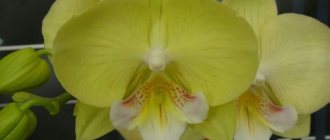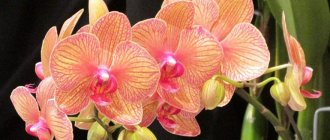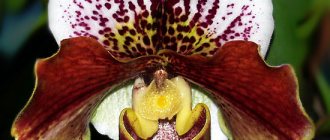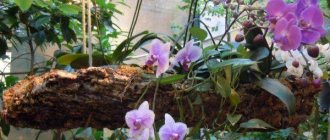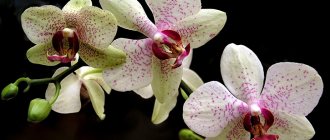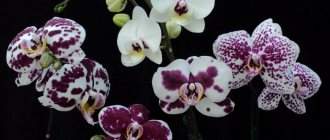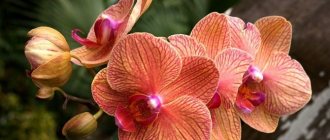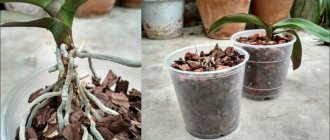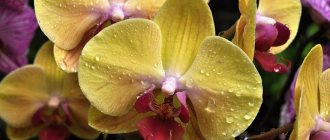Europeans became acquainted with magnificent orchids more than three hundred years ago. The first specimens of these tropical plants, which arrived from the American continent to Holland, amazed even experienced flower growers with their exquisite appearance and duration of flowering .
But in those distant times, exotic beauties could only grow in royal greenhouses. Nowadays, blooming orchids can be seen not only on the windowsills of ordinary apartments.
They fit harmoniously into the interiors of offices and educational institutions, decorate hospitals and libraries, plant greenery in the halls of enterprises and even personal gardens . The successes of flower growers in the study of orchids and the efforts of breeders allowed tropical guests to firmly establish themselves in the homes and hearts of people of the 19th century.
General information about the Phalaenopsis orchid
Appearing in Europe half a century later (1752) than the first orchids, the Phalaenopsis orchid, a representative of the southeastern regions of Asia, also captivated flower growers with its regal appearance , elegant and long-lasting flowering, and most importantly, its unpretentiousness in home culture.
The Phalaenopsis genus includes a fairly large number of species (according to various sources - from 70 to 77), but they are all characterized by a number of similar features:
- Representatives of the genus are monopodial plants, that is, they develop strictly upward due to the apical growth point. They have one strongly shortened stem and a dense rosette of evergreen voluminous and fleshy leaves of a juicy color .
- A distinctive feature of all species is large flowers, collected in rich racemose inflorescences on high peduncles.
- Flowering duration ranges from 3 weeks to 5 months. In many species, repeated flowering is possible on the same peduncle.
- Roots with a thick layer of velamen in most species participate in the process of photosynthesis due to the chlorophyll they contain. Therefore, transparent flowerpots are desirable for Phalaenopsis.
- Almost all species do not have a rest period; they need constant warm conditions . But for successful flowering, a temperature difference (3-5°C) during the day is required.
On a note! Any Phalaenopsis is an ideal choice for beginning gardeners, as it is unpretentious in care and can adapt to the conditions of a particular room.
Katasetum
Fans of confectionery art will easily recognize the smells of Catasetum - rare orchids whose flowers smell of freshly baked rye bread and malt muffins. These are sympodial orchids with oval pseudobulbs very tightly pressed together, much like cigars with a pointed end (they can grow up to 20 cm in length).
Catasetum. © Sylvio Rodrigues Pereira
Even during the dormant period, only young pseudobulbs are leafy; from the second year, lanceolate leathery leaves with longitudinal veins fall off. This deciduous orchid simultaneously produces large male flowers, up to 12 cm in diameter, and small female flowers.
Only the first ones can boast of high decorativeness - turned upside down, with a funnel-shaped lip, oval sepals and petals. The unique dark red, chocolate colors contrasting with the yellow and green lip only highlight how unusual this orchid is.
Popular varieties in home culture
Among the numerous varieties of Phalaenopsis, any gardener will be able to select specimens to suit their taste or based on the needs of the collection.
Interesting! The corollas of Phalaenopsis are similar in appearance to butterflies, which gives the name to the whole genus (moth-like). The color palette of flowers includes all rainbow shades, which further increases the resemblance to delicate insects.
For beginners and amateurs, we can recommend the most common varieties in home cultivation, photos of which will help you make a choice.
Phalaenopsis mix
A hybrid specially adapted for indoor culture. Requires minimal care . A large plant (height with peduncle reaches 0.7 m) with large butterfly flowers of all shades of the rainbow.
The leaves are standard for the genus - large, leathery, oval-round in outline . It blooms multiple times in one year with long periods of corolla retention.
Phalaenopsis blue
There are no consistently blue varieties in nature. Several hybrid forms and natural varieties are known with delicate and subtle tones of blue and lilac (sometimes on a white background).
All bright blue specimens sold are tinted with natural dyes using a special technology. The second flowering of such forms is usually white or pale blue , but not all sellers honestly warn about this.
Other characteristics depend on the variety chosen for tinting.
Phalaenopsis Philadelphia
A distinctive feature is large, oval-elongated leaves with a marble pattern, covered with a glossy coating. The inflorescences are of medium height and branch well . It blooms gently with lilac butterflies.
Phalaenopsis Stewart
It is distinguished by narrow, long leaves with light patterns, as well as silvery roots. Multi-flowered inflorescences - sometimes about 60 buds at a time on high peduncles (up to 80 cm) bear small white fragrant corollas.
Blooms during warm periods. Duration – no more than 30 days.
Phalaenopsis Magic Art
Not a very large orchid (about 60 cm) with oval dark green leaves . It is distinguished by brightly colored corollas: crimson droplets are scattered across the white petals, complemented by streaks of the same color.
The middle is red with crimson and yellow tints . Blooms twice a year.
Unusual Phalaenopsis are very popular in culture:
Dendrobium Phalaenopsis
Belongs to the genus Dendrobium, it received its name for the resemblance of the corollas to butterfly orchid flowers.
Dendrobium Phalaenopsis has a sympodial type of growth , that is, it can grow in width due to the formation of new shoots on the rhizome. The leaves are long and narrow. The inflorescences are formed from pseudobulbs, the flowers are white to purple in color.
Phalaenopsis mini
The Phalaenopsis mini orchid differs from other species only in its insignificant peduncle height (no more than 20 cm). It has large thick leaves of green (less often spotted) color .
Blooms both in summer and winter months. Flowers are butterflies of various shades.
Types of colors
- Under natural conditions, there are different colors of this species. Flowers can be white, pink and purple. Sometimes there are blue, black and white-violet shades. There are also red orchid flowers with small white and pink speckles. There are also lemon, chocolate and orange colors.
- Artificially bred orchids have a variety of colors and combinations of color shades: from white, fiery red, orange to blue and purple. Also, some varieties are presented in a white-pink or yellow color palette.
How to choose Phalaenopsis in the store
In order for the orchid to quickly adapt to its new apartment conditions and feel comfortable, when purchasing a plant you should take into account some nuances:
- It is possible to determine the color of a future pet only in a blooming state. In addition, blossoming buds without disturbing the richness of color , firmly sitting on the peduncle, will show a healthy plant. – Buy an orchid during flowering.
- A sick plant will be revealed by its root system: if the roots are sluggish, with spots of rot, and the orchid sways in the pot when touched, then you should not buy it (the flower is weakened). – When purchasing, check the health of the roots.
- A healthy orchid certainly has powerful, fleshy leaves . They should not have cracks, scratches or dry areas. Most varieties have dark greens. – When buying an orchid, pay attention to the leaves.
History of origin
Phalaenopsis Mini Mark is a hybrid, the result of several crosses, bred at the end of the 20th century . The hybrid variety "Micro Nova" was originally developed in 1980 by Henry Welbrunn. His followers - “Mini Mark”, “Luddemana” were obtained by crossing the original hybrid “Micro Nova” with the natural phalaenopsis variety Mini Mark.
Orchid subcultivars have gained wide popularity and received many awards. The most prominent representatives are the clones “Timothy Christopher”, “Cassandra”, “Brother Pico Polo”, etc.
Caring for an indoor orchid
Orchids of the genus Phalaenopsis have the ability to quite easily adapt to the conditions in which they have to grow. For this reason, they are rightfully considered the most unpretentious and easy to keep exotic beauties.
Even a beginner in the art of floriculture can take care of a butterfly orchid at home
Important! The orchid is a representative of the tropical flora. This means that she has a slightly different approach to environmental factors: she loves a lot of light, moisture and warmth. Proper care after purchasing a Phalaenopsis orchid is aimed at creating for it a life close to its natural habitat.
Placement and lighting
The ideal location for butterfly orchids is on south-facing window sills. With this option, the plant will receive enough sunlight even in the cold months . But in summer, a shading system should be provided from direct rays of the sun to protect the flower from burns.
Location on the windows of the eastern and western sides of the rooms is also acceptable when keeping orchids. In this case, the light will be diffused, and its quantity will be sufficient for normal life activity, including long-term flowering.
If the plant is forced to be located on the northern window of the room, then in order to maintain the proper level of illumination it is necessary to provide additional illumination with daylight spectrum lamps, especially in the winter months. Otherwise, the plant will not have enough strength to form buds (they will be spent on leaf growth), and immunity may decrease. And this threatens health.
For any arrangement, it is recommended to periodically rotate the Phalaenopsis pot to create a harmonious outline.
Temperature
The butterfly orchid is quite thermophilic: the optimal temperature range is +18 +24°C. Under such conditions, the plant will experience sufficient growth of green mass and lush flowering for several weeks (and even months).
A short-term decrease in temperature to +14 +16°C is acceptable, but prolonged cooling is fraught with a slowdown in life cycles.
Keeping a flower for a long time in hot conditions (above + 28°C) can provoke rapid leaf growth with a simultaneous deterioration in the quality and duration of flowering .
Almost all types of Phalaenopsis bloom several times a year; they do not have a pronounced dormant period. Therefore, to ensure stable flowering, the plant requires a daily temperature change of approximately 5°C. In cold weather, such conditions develop naturally on the windowsill. In summer, it is advisable to open the window at night.
Advice! When trying to create a daily temperature difference for an orchid, it is necessary to monitor the movements of air masses. Phalaenopsis reacts negatively to drafts!
Humidity and watering
The well-being of a flower largely depends on the air humidity in the room and proper watering.
The butterfly orchid has a twofold attitude towards humidity. The ideal for her is values ranging from 60 to 80%, but the tropical beauty can easily adapt to significantly lower numbers (that is, to the usual air humidity of city apartments). The main thing is not to allow the threshold to drop below 40%.
If necessary, air humidity can be changed using humidifiers, spraying or trays of pebbles and water.
Important! Increasing humidity can combat elevated temperatures, but it requires more frequent ventilation.
Having decided to purchase Phalaenopsis, you should think about the watering schedule in advance, taking into account different periods of the growing season and how to prevent the soil from overflowing or drying out .
This video explains how to care for phalaenopsis orchids at home.
The orchid should be watered regularly, but sparingly throughout the year.
Each subsequent watering depends on weather conditions and is carried out after the soil has dried out a little : the orchid tolerates minor drought more easily than heavy moisture.
Attention! You can determine the time of watering by the color of the roots: the green color indicates that the roots are full of moisture, the drying of the soil will be marked by the silver-gray tonality of the root system.
All procedures with water (watering, spraying) are carried out in the first half of the day so that the plant does not cool down at night. Watering is allowed only by immersion method.
Soil and fertilizers
Since Phalaenopsis roots are involved in the process of photosynthesis, they require a loose and breathable substrate. It would be ideal to use bark harvested from the forest and boiled to remove pests and resin.
It is allowed to keep the plant without a substrate - the roots must be fixed on a special block or simply in a wooden basket.
Butterfly orchids do not require the use of fertilizers, since they independently obtain all the elements from the environment.
Features of cultivation
Blooming purple orchids in an indoor pot are a worthy interior decoration. However, it should be remembered that such a houseplant requires proper care and special growing conditions. The biggest feature of keeping the plant is represented by the absence of the need to use soil soil.
To give the plant stability, special pots or glass containers should be filled with a substrate based on tree bark. It is necessary to take into account the fact that these plants love light, but react poorly to bright sun. In addition, it is extremely important to maintain high levels of air humidity, as well as observe special temperature indicators day and night.
Orchid transplant
Orchids do not like interference in their life processes, so transplants should be done as rarely as possible: in case of damage to the bark (flooding or caking) , to increase the volume of the pot, or due to the appearance of pests. Ideally, one transplant every 3 years.
Transfer rules
The transplant procedure should be thought out in advance step by step:
- Remove the orchid from the pot by cutting the container;
- Rinse the root system;
- Remove damaged and diseased roots, yellow and old leaves, treating all cuts with charcoal;
- Dry the roots, place in a new pot and sprinkle with bark;
- After transplantation, do not water for about a week, keep in a warm and bright place;
- Next, treat the bark every morning with a solution of succinic acid to increase immunity and accelerate growth.
This video shows how to re-salt an orchid after purchase.
Potty requirements
Phalaenopsis, due to the characteristics of the root system - the presence of chlorophyll and participation in photosynthesis - love transparent plastic pots , but you can also use blocks or baskets (when growing a flower without soil). Read more about orchid pots.
Can it be kept outdoors?
It is not recommended to keep the flower outdoors . Exotic is not grown in our climatic conditions in open ground.
You will find characteristics and features of growing other varieties of orchids - Cambria, Zygopetalum, Oncidium, Kaoda, Multiflora, Vanda, Cattleya, Sogo, Vanilla and Dracula - in our separate articles.
Orchid blossom
The most important moment in the life cycle of an orchid, which all Phalaenopsis owners look forward to, is the flowering period.
In Phalaenopsis it occurs at different times , with different frequency and duration (depending on the species). But it's always a great spectacle.
Conditions required for Phalaenopsis to bloom
To form flower buds, an orchid requires very little - only careful adherence to all rules and maintenance regimes :
- It is necessary to maintain constant lighting levels throughout the year whenever possible;
- Use lighting in winter;
- Try to create a daily temperature difference.
Even in the absence of any point, the Phalaenopsis orchid will try to bloom at least once a year , because it is not without reason that it is the most unpretentious beauty.
Why doesn't it bloom?
Mistakes made when caring for Phalaenopsis contain the answer to the question: the orchid does not bloom, what should I do? Possible reasons include:
- Lack of lighting;
- Root rotting due to overwatering;
- Lack of daily changes or extreme heat ;
- Stress after transplant;
- Bacterial diseases;
- Excessive fertilizing with nitrogen.
If the last flowering took place more than a year ago , and the plant is not trying to form a peduncle, then all care regimens should be adjusted.
Phalaenopsis has faded, what to do next?
The following tips will help you decide how to care for a faded orchid:
- Do not remove the green peduncle - possible re-blooming or the formation of a baby Phalaenopsis orchid on a peduncle;
- Trim only completely dried arrows at the root;
- Cut the peduncle back to the first living meristem (dormant bud) in hopes of repeat flowering.
But if the plant is weakened, then after the flowers fade, it is advisable to immediately cut off the arrow to give the orchid time to recover.
Reproduction of phalaenopsis
To obtain new orchids of the Phalaenopsis genus, flower growers have two options: sexual reproduction (by seeds) and vegetative reproduction (by children). The seed method is too complicated and not always successful. It is used by experienced breeders to develop new varieties.
The simplest thing is to get a baby from your orchid. Sometimes vegetative propagation occurs without human intervention. The baby is formed from meristems on the arrow left after flowering or in the axils at the base of the leaves. In some cases, gardeners resort to stimulating the orchid to form layering using growth stimulants.
Occasionally, the children that appear do not want to produce roots . This happens due to mistakes in caring for the mother orchid. Experienced gardeners will tell you how to grow roots in this case:
- Separate the baby with a piece of peduncle, secure it on the foam so that the end of the stem is above the small hole, but does not touch the water in which the impromptu boat will float.
- Place the baby on sphagnum moss in a mini greenhouse .
- Try to get roots without separating the baby from the mother plant, wrapping it in moss and wetting the resulting cocoon.
General information
“Phalaenopsis violet” is known to many under the name “Phalaenopsis violation”. The name of the houseplant comes from the Latin "Phalaenopsis violacea" . Photos of this epiphytic herbaceous plant of the orchid family fascinate with their beauty. “Phalaenopsis violet” has an unusual color, but does not have an established Russian name. In Russian-language sources, the indoor plant of this species is most often called the purple orchid; flower growers also use the scientific name.
A feature of the species status is the inaccurate knowledge of the origin of this plant. Many believe that the purple Phalaenopsis is a natural variation of Phalaenopsis bellina. Other authors describe the similarity in the photo with “Phalaenopsis violacea”. A miniature version of a monopodial deciduous epiphyte can be clearly seen in the photograph. The plant has a solid peduncle that can bend in a zigzag manner and bear a small number of flowers.
The flowers of the plant are characterized by a waxy appearance and have a pleasant, pronounced aroma that can be compared with the smell of water lilies, as well as freesia or bergamot. The diameter of the flowers does not exceed 6 cm. The petal part of the flowers is clearly visible in the photograph of “Phalaenopsis violet” and has an elliptical or oval-elliptical shape. The flowering plant is quite common throughout the year, and the mass flowering stage begins in spring and continues until autumn . A variety of color options are presented in the photographs of this plant.
"Phalaenopsis violet" has fleshy, elliptical or oblong-elliptical, sharp or blunt leaves. Mature plants have powerful leaves, the length of which can exceed 25 cm and the width reaches 12 cm.
Phalaenopsis diseases
Diseases can be caused by errors in care, fungi or bacteria.
Sticky spots on leaves
If the plant suffers from uncomfortable conditions, sticky drops may appear on the leaves of the Phalaenopsis orchid. These glue-like droplets give a signal to revise your care regimen.
But sometimes the drops appear as protection against pests or as a means of attracting pollinators . In these cases, there is no need to worry.
Decreased leaf turgor
If the question arises: how to restore leaf turgor in a Phalaenopsis orchid, you should care for the plant based on the reasons that caused this problem .
Loss of turgor is also caused by improper care: compacted soil, overheating of the underground part, uncontrolled watering. The cause should be found out and care adjusted .
Hives
Phalaenopsis disease is characterized by small spots (up to 3 cm) on leaf blades.
The reason lies in the cold and too humid air of the room without sufficient ventilation. To combat urticaria, it is enough to change the conditions of care.
Fusarium
A disease that is dangerous for an orchid is caused by fungi that have entered the roots and base of the stem through the soil. Causes rotting of the underground parts of the plant, which gradually spreads to the above-ground parts.
Carefully! Fusarium can only be treated before rot appears, so when pinkish-white dust particles are first detected, the orchid is quarantined and treated with fungicides.
When plants rot, they must be destroyed to prevent mass infection.
Botrytis
A fungal disease characterized by brownish and black speckles on buds and flowers. It occurs due to moisture getting on the petals and in the axils of the leaves.
Botrytis disrupts the decorative effect and, without treatment, can lead to the death of the orchid. To cure, the affected parts should be removed and treated with a fungicide .
Please also pay attention to the beneficial effect of succinic acid on orchids both for diseases and for prevention.
Phalaenopsis pests
Of the parasites that affect Phalaenopsis, the most dangerous are thrips , spider mites, scale insects, mealybugs and slugs. Measures to combat them include preventive examinations and treatment with insecticides when infected.
Love your Phalaenopsis orchid, take care of it, and the orchid will respond with magnificent blooms .
This video talks about mistakes in caring for the Phalaenopsis orchid and how to grow a healthy plant.
